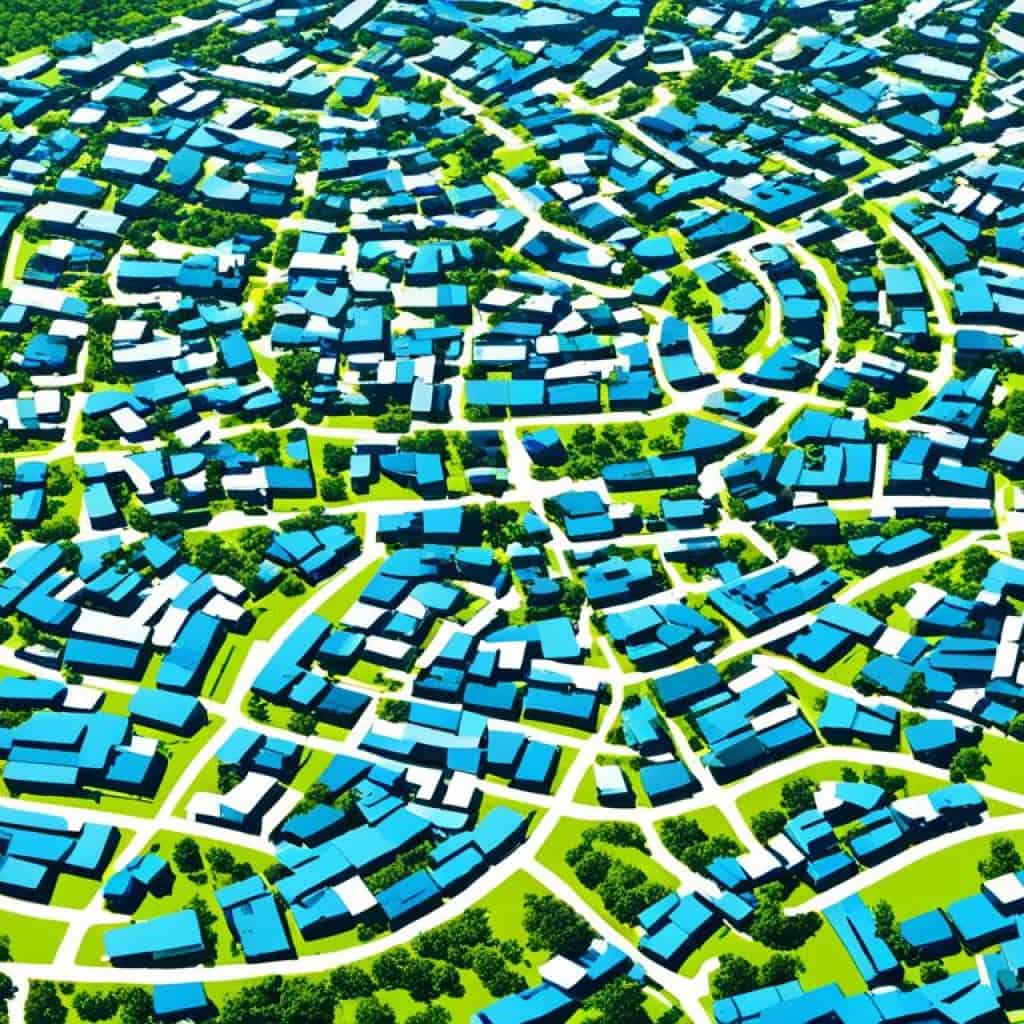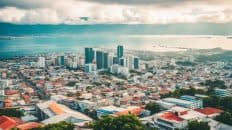Did you know that the Philippines is projected to have a population of around 115 million by the end of 2023? As one of the largest cities in the country, Cebu City on Cebu Island is experiencing its own unique population trends. But what exactly are these trends and how will they shape the future of Cebu City?
According to the Commission on Population and Development (CPD), the Philippines is currently ranked 13th among the most populous nations in the world. With such a significant population, understanding the demographics of Cebu City is crucial for planning and development.
Key Takeaways:
- The Philippines is projected to have a population of around 115 million by 2023.
- Cebu City is one of the largest cities in the country and is experiencing unique population trends.
- Understanding the demographics of Cebu City is essential for planning and development.
Global Population Growth
The global human population growth is a significant concern due to its impact on resources and sustainability. With an annual growth rate of 1.1%, the world population increases by approximately 83 million people each year. This exponential growth has resulted in the current world population reaching 7.9 billion in 2020, up from just 1 billion in 1800.
The continuous increase in the global population raises important questions about the availability of essential resources such as food, water, and energy. Overpopulation can strain these resources, leading to potential shortages and environmental degradation.
To ensure a sustainable future, governments worldwide have implemented various measures to control population growth. These include family planning programs, education initiatives, and policies promoting reproductive health. However, despite these efforts, population growth remains a significant challenge.
Negative Population Growth in Cebu City
In certain barangays (villages) in the north district of Cebu City, such as Lusaran, Kabulihan, Pari-an, and Sto. Niño, there is evidence of negative population growth. This phenomenon refers to a population decline or contraction in these areas. For instance, Lusaran has experienced a significant decrease in population from 2,931 in 2015 to 2,595 in 2020, representing an 11.46% decrease. Similar trends have been observed in downtown barangays like Kalubihan and Sto Niño.
This demographic report raises questions regarding the underlying factors contributing to this population decline. While the available data does not explicitly state the reasons, it is unclear whether economic factors or political implications play a role. It’s important to note that population size alone does not necessarily correlate with personalized services or community development.
| Barangay | 2015 Population | 2020 Population | Percentage Change |
|---|---|---|---|
| Lusaran | 2,931 | 2,595 | -11.46% |
| Kalubihan | 4,552 | 4,342 | -4.61% |
| Sto. Niño | 3,711 | 3,487 | -6.03% |
Source: Cebu City Demographic Report, 2020
Factors Impacting Population Decline
The population decline observed in certain downtown barangays (villages) in Cebu City can be attributed to a combination of factors, although the precise reasons are not explicitly stated in the available data. It is essential to explore both the economic and political implications that may contribute to this decline and shape the demographic landscape of these areas.
When examining the downtown barangays experiencing negative population growth, it is crucial to consider the economic conditions within these communities. Economic factors such as limited job opportunities, lack of investment, and higher living costs can often lead individuals and families to relocate to areas offering better prospects and a higher quality of life.
Additionally, political considerations may also play a role in population decline. Instances of political instability, governance issues, and inadequate local policies can create an unfavorable environment for residents, leading to their decision to leave these areas in search of more stable and prosperous communities.
“The reasons behind the population decline in certain downtown barangays, particularly in Cebu City, are multifaceted. While economic factors like limited job opportunities and higher costs of living could contribute to this decline, political red flags and governance issues may also influence residents’ decisions to relocate.”
It is important to note that population size alone does not necessarily reflect the level of personalized services or development within a community. Larger populations may not always result in improved living conditions or increased access to essential amenities.
Understanding the factors contributing to population decline in downtown barangays is crucial for policymakers and community leaders. By addressing economic challenges, improving governance, and implementing policies that foster sustainable development, it is possible to reverse the declining population trend and create thriving communities that offer a high quality of life for their residents.
Legislative Considerations for Merging Barangays
The Local Government Code provides the Sangguniang Panlungsod with the authority to create and merge barangays, enabling them to adapt to changing circumstances and optimize resources for better service delivery. In light of the declining population in certain small population villages such as Kabulihan and Sto Nino, the Cebu City Council can explore the legislative paradigm of merging these barangays to address the challenges they face.
Merging barangays presents an opportunity to consolidate administrative functions and streamline services, resulting in improved efficiency and effectiveness. By combining limited resources and reducing duplication of efforts, the local government can allocate more funding towards vital infrastructure projects, social services, and community development initiatives.
The merger process should involve a thorough assessment of the potential benefits and impacts on the affected barangays. It is important to consider the proximity, cultural dynamics, and economic activities of the villages to ensure a harmonious integration. Public consultations and dialogues can help address any concerns or reservations from the residents and create a sense of ownership among all stakeholders.
“Merging barangays requires careful consideration of the unique characteristics and needs of each village. It is essential to strike a balance between preserving the identity and heritage of the communities while pursuing the greater goal of sustainable development.” – City Council Member, Cebu City
By adopting a strategic approach to merging barangays, the local government can unlock potential synergies and foster collaboration among villagers. The consolidation of resources can lead to economies of scale, facilitating the delivery of essential services such as healthcare, education, and infrastructure development.
The Benefits of Barangay Merging
Merging barangays offers several advantages. Firstly, it can strengthen local governance by creating larger administrative units that are better equipped to address the needs and concerns of their constituents. This consolidation can lead to more robust decision-making processes and improved coordination among local government officials.
Secondly, merging barangays can enhance the sharing of resources and expertise. It allows for the pooling of financial resources, resulting in improved financial sustainability and a more equitable distribution of funds within the merged barangay. Additionally, the consolidation of administrative resources can promote knowledge exchange and innovation, leading to improved service delivery.
Lastly, merging barangays can facilitate the implementation of long-term development plans and strategies. By aligning the goals and objectives of each village, the local government can foster a unified vision for progress and leverage resources more effectively. This consolidation can enhance the capacity to attract investments, promote economic growth, and create a more conducive environment for sustainable development.
| Merging Barangays | Benefits |
|---|---|
| Optimization of resources | Improved service delivery |
| Enhanced governance | Better decision-making processes |
| Sharing of resources and expertise | Financial sustainability and equitable distribution of funds |
| Promotion of unified vision | Effective implementation of development plans |
Overall, merging barangays can be an effective legislative strategy for addressing the challenges faced by small population villages and promoting sustainable development. Through careful planning, stakeholder engagement, and a focus on optimizing resources, the local government can create a stronger, more resilient community that is better equipped to meet the needs of its residents.

Cebu City’s Historical and Economic Significance
Cebu City, the oldest settlement in the Philippines, boasts a rich history and is renowned for its Spanish heritage. Situated on Cebu Island’s eastern coast, this vibrant port city serves as a major collection center for various interisland commodities. It is home to numerous industrial and commercial firms, contributing to its thriving commercial core. Additionally, Cebu City plays a pivotal role in the cultural and economic landscape of the central Visayan region.
Since its establishment, Cebu City has witnessed the influence of Spanish colonization, leaving behind a significant architectural and cultural legacy. The city’s historical landmarks, such as Magellan’s Cross and the Basilica Minore del Santo Niño, reflect its Spanish heritage and attract tourists from around the world.
Cebu City’s strategic location has positioned it as a bustling port, facilitating trade and commerce both domestically and internationally. With a well-developed infrastructure and a comprehensive transportation network, the city acts as a gateway to the Visayas and Mindanao regions, further enhancing its economic significance.
As the commercial core of the region, Cebu City boasts a diverse economy driven by various industries, including manufacturing, tourism, and services. The city’s busy port supports trade activities, contributing to its economic vitality. Furthermore, Cebu City’s commercial districts, such as the bustling Carbon Market and the upscale Ayala Center, attract locals and tourists alike, further fueling economic growth.
To gain a better understanding of Cebu City’s historical and economic significance, let’s examine the following table:
| Year | Historical Events | Economic Milestones |
|---|---|---|
| 1565 | Ferdinand Magellan arrives in Cebu | – |
| 1595 | Establishment of the Basilica Minore del Santo Niño | – |
| 1738 | Construction of the Magellan’s Cross | – |
| 1855 | Formation of the Municipality of Cebu | – |
| 1901 | American colonization begins | – |
| 1961 | Cebu International Airport opens | Influx of tourism revenue |
| 1986 | People Power Revolution in the Philippines | Growth of the services sector |
| 2010 | Opening of the Mactan-Cebu International Airport Terminal 2 | Expansion of air transportation and tourism |
The exciting history and dynamic economy of Cebu City continue to shape its identity as a significant cultural and economic hub in the Philippines. The city’s heritage, thriving port, and bustling commercial core make it a vital player in the country’s overall development and growth.
Economic Contributions and Industries in Cebu City
Cebu City, located on Cebu Island in the Philippines, is not only known for its historical heritage but also for its vibrant economy. The city is home to a wide range of industries that drive its economic growth and contribute to the region’s overall development.
Some of the major industries in Cebu City include textiles, footwear, processed foods, vegetable oil, furniture, and chemicals. These industries provide employment opportunities and contribute significantly to the city’s economy. Commercial firms in Cebu City play a crucial role in promoting trade and commerce within the region.
Moreover, Cebu City serves as a hub for passenger traffic, with an international airport located on Mactan Island. This airport connects Cebu City to various domestic and international destinations, facilitating business transactions and tourism. The airport’s presence further strengthens the city’s economic position and encourages investment in the region.
Cebu City’s strategic location and robust economic activities attract many Manila-based companies, which establish branches in the city to tap into its lucrative business prospects. This influx of commercial enterprises enhances the city’s economic landscape and fosters job creation and economic growth.
Major Industries in Cebu City
| Sector | Industries |
|---|---|
| Textiles | Garments, fabrics, and textiles manufacturing |
| Footwear | Shoes and footwear production |
| Processed Foods | Food processing and manufacturing |
| Vegetable Oil | Vegetable oil production and refining |
| Furniture | Furniture manufacturing and export |
| Chemicals | Chemical production and distribution |
This diverse array of industries in Cebu City underscores the city’s economic resilience and sustainability. By fostering a conducive business environment and investing in key sectors, the city continues to thrive and contribute significantly to the overall economic development of the Philippines.
Cebu City’s Education Landscape
Cebu City, known for its vibrant culture and economic significance, is also home to several renowned universities and education centers. These major institutions contribute immensely to the city’s reputation as a center of education within the region. Whether you’re pursuing higher education or seeking professional development, Cebu City offers a wide range of educational opportunities to cater to different interests and aspirations.
Among the notable universities in Cebu City is the University of San Carlos, one of the country’s leading educational institutions. It offers various undergraduate and graduate programs, including courses in business, engineering, architecture, and liberal arts. Another prominent institution is the Cebu Institute of Technology, which is well-regarded for its engineering and technology-focused programs.
Southwestern University is another key player in Cebu City’s education landscape, offering programs in medicine, dentistry, pharmacy, and other health-related fields. The University of the Southern Philippines is renowned for its courses in law, education, and business administration, attracting students from across the country. Additionally, the University of the Visayas offers a diverse range of programs, including courses in nursing, marine engineering, and hospitality management.
These universities and education centers not only provide quality education but also contribute to the city’s overall development. They attract students and professionals from different parts of the country, fostering cultural exchange and intellectual growth. By nurturing talent and providing a conducive learning environment, Cebu City’s educational institutions play a crucial role in shaping the future of individuals and the community as a whole.
Educational Opportunities in Cebu City
In addition to the major universities mentioned above, Cebu City is also home to numerous technical and vocational schools, language centers, and specialized training institutes. These institutions offer a diverse range of programs, including culinary arts, fashion design, language courses, and IT certifications.
Moreover, Cebu City provides ample opportunities for lifelong learning and personal development. The city hosts workshops, seminars, and conferences on various topics, allowing individuals to expand their knowledge and gain new skills. Whether one seeks to advance their career or explore new fields of interest, Cebu City’s education centers cater to diverse learning needs.
“Education is the most powerful weapon which you can use to change the world.” – Nelson Mandela
The Impact of Education on the Community
Investments in education have far-reaching effects on society. By producing well-educated individuals, Cebu City’s universities and education centers contribute to the development of a skilled workforce, benefiting industries and the local economy. Education empowers individuals, enabling them to secure better employment opportunities and improve their quality of life.
Furthermore, education plays a vital role in promoting social cohesion and fostering a sense of community. Through educational institutions, individuals from different backgrounds come together, exchanging ideas and experiences, and developing a deeper understanding and appreciation for diversity.
As Cebu City’s education landscape continues to grow and evolve, it reinforces the city’s position as a hub of knowledge and innovation. With a focus on academic excellence and holistic development, Cebu City’s major institutions are shaping the future leaders, professionals, and change-makers of tomorrow.
| University | Programs Offered |
|---|---|
| University of San Carlos | Business, Engineering, Architecture, Liberal Arts |
| Cebu Institute of Technology | Engineering, Technology |
| Southwestern University | Medicine, Dentistry, Pharmacy |
| University of the Southern Philippines | Law, Education, Business Administration |
| University of the Visayas | Nursing, Marine Engineering, Hospitality Management |
Population Growth and Age Structure in the Philippines
The Philippines has experienced a notable shift in population growth patterns, primarily driven by the declining total fertility rate. The average number of children born to women of reproductive age has decreased to approximately two children. As a result, there has been a significant change in the age structure of the population, with a dominant working-age group ranging from 15 to 64 years old.
This demographic transition holds great potential for economic development and sustainability. The presence of a sizeable working-age population fuels productivity, innovation, and entrepreneurship, contributing to overall economic growth. These individuals form the backbone of the labor force, driving various industries and sectors.
Implications for Economic Development
The abundance of a working-age population provides key benefits for economic development in the Philippines. With a large pool of individuals in their prime working years, there is a greater potential for improved productivity, increased consumer demand, and enhanced labor market dynamics.
Furthermore, a substantial working-age population allows for a more effective distribution of resources and skill sets within the economy. This helps to fuel innovation and technological advancements across various industries, fostering economic competitiveness on both the national and global scale.
Investing in Human Capital
To fully capitalize on the potential economic benefits associated with a dominant working-age population, it is crucial to invest in human capital development. This entails providing quality education, vocational training, and relevant skills development opportunities.
By equipping individuals with the necessary knowledge and skills, the workforce becomes more adaptable and responsive to emerging market needs. It enables workers to meet the demands of a changing economy, fostering sustainable economic growth and socioeconomic progress.
The Role of Government Policies
Government policies play a vital role in harnessing the potential of a working-age population for economic development. Policies should focus on promoting inclusive growth, reducing unemployment rates, and enhancing labor market conditions.
Additionally, the government can implement measures to support entrepreneurship and innovation, creating an enabling environment for businesses to thrive. This includes providing financial incentives, improving infrastructure, and simplifying regulatory frameworks.

Age Distribution in the Philippines (2021 est.)
| Age Group | Percentage of Population |
|---|---|
| 0-14 Years | 28.7% |
| 15-64 Years (Working-age Population) | 65.9% |
| 65 Years and Above (Elderly Population) | 5.4% |
The table above presents the age distribution in the Philippines as of 2021. Notably, the working-age population (15-64 years) represents a significant majority, accounting for approximately 65.9% of the total population. This highlights the potential economic strength and productivity of the country.
Overall, the demographic transition towards a dominant working-age population in the Philippines presents a unique opportunity for sustained economic development. By effectively harnessing this demographic dividend through strategic investments in education, skills development, and supportive government policies, the country can pave the way for a prosperous and inclusive future.
The Implications of Manageable Family Size
When families have a manageable number of children, there is typically more investment in their health, education, and overall well-being. By practicing responsible family planning, parents can ensure that they can provide the necessary resources and attention to each child, setting the groundwork for a bright future.
Investment in children’s well-being is crucial for their development. With fewer children to care for, parents can allocate more time, energy, and financial resources towards their children’s health needs, including regular check-ups, vaccinations, and nutritious meals. This investment in family health contributes to raising healthy, happy, and resilient children.
Education is another area where manageable family size plays a significant role. Parents with a small number of children can devote more quality time to each child’s education, aiding their academic progress and intellectual growth. They can provide educational materials, enroll them in extracurricular activities, and support their learning journey, increasing their chances of success and future opportunities.
“Family planning ensures that children can receive the education, healthcare, and nurturing they need to thrive in every aspect of their lives, setting them up for a brighter future.”
Family planning is an essential component of accessible and comprehensive reproductive health services. By empowering individuals and couples to make informed decisions about their reproductive health, family planning ensures that every child is a wanted child. It enables parents to space their pregnancies, which can positively impact the health of both the mother and child, reducing the risks associated with closely spaced pregnancies.
The Commission on Population and Development (CPD) in the Philippines is actively addressing issues related to teenage pregnancy and promoting responsible family planning practices. Through educational campaigns, access to contraceptives, and reproductive health services, they aim to empower individuals to make choices that align with their desires and aspirations.
The Benefits of Family Planning
Family planning offers numerous benefits, not only for individual families but also for communities and society as a whole:
- Improved maternal and child health
- Reduced infant and child mortality rates
- Increased economic opportunities for women
- Reduced poverty rates
- Enhanced educational attainment
- Greater gender equality
By promoting and supporting manageable family sizes, societies can achieve sustainable development and create an environment where every child has the opportunity to reach their full potential.
| Investment in children’s well-being | Family health | Education | Family planning |
|---|---|---|---|
| Increased resources for health needs | Time, energy, and financial resources | Quality time and educational support | Empowered decision-making |
| Healthcare, vaccinations, and nutrition | Healthy, happy, and resilient children | Academic progress and growth | Controlled pregnancy spacing |
| Opportunities for success | Reduced health risks |
Cebu City’s Role in Economic Development
Cebu City plays a crucial role in the economic development of the region, making significant contributions to various sectors and driving sustainable growth. Its population dynamics are closely intertwined with the city’s economic prosperity, creating a symbiotic relationship between the two.
By investing in human resources, particularly the working-age population, Cebu City can propel economic development to new heights. The abundance of skilled workers and a larger labor force significantly contribute to the city’s economic output and productivity. This translates into increased economic contributions and enhanced competitiveness in domestic and international markets.
The government’s support is paramount in nurturing this favorable environment for economic growth. Policies and initiatives that promote entrepreneurship, innovation, and business-friendly regulations ensure the sustainability of Cebu City’s economic ecosystem. It is through these collaborative efforts that businesses thrive, leading to job creation, increased investments, and overall economic stability.
Human Resources and Sustainable Growth
The city’s human resources are vital to maintaining sustainable growth. With a focus on education and skill development, Cebu City nurtures a talented workforce that is adaptable to changing market demands. This ensures that industries have the necessary skills and expertise to remain competitive on a global scale.
Cebu City’s commitment to sustainable growth is further exemplified through responsible resource management. The city adopts practices that minimize its ecological footprint, striving for a balance between economic development and environmental preservation. By embracing sustainable practices, Cebu City aims to create a thriving and resilient economy that can be enjoyed by future generations.
“Cebu City’s economic growth is fueled by its human resources, government support, and commitment to sustainable development. Together, these factors contribute to a thriving economy that benefits both businesses and residents.”
The Way Forward
Looking ahead, Cebu City’s continued investment in human resources, along with strategic government support, will pave the way for sustained economic growth. By harnessing the potential of its population and maintaining a business-friendly environment, the city can withstand economic uncertainties and foster long-term prosperity.
| Economic Contributions | Human Resources | Government Support | Sustainable Growth |
|---|---|---|---|
| Increased GDP | Skilled Workforce | Business-Friendly Policies | Environmental Stewardship |
| Job Creation | Educational Institutions | Investment Incentives | Responsible Resource Management |
| Industry Diversification | Continuous Skills Development | Infrastructure Development | Long-Term Economic Stability |
Infrastructure and Connectivity in Cebu City
Cebu City prides itself on its robust transportation network, providing seamless connectivity for both locals and visitors. The city is home to the Mactan-Cebu International Airport, serving as a gateway to international and domestic destinations.
Additionally, Cebu City benefits from a well-developed railway system that connects the city to nearby areas, further enhancing accessibility. The coastal railway network allows for efficient and convenient travel, supporting economic activities and fostering regional integration.
International Airport: Connecting Cebu to the World
The Mactan-Cebu International Airport is a bustling hub, catering to both business and leisure travelers. With its modern facilities and efficient operations, the airport serves as a vital link between Cebu City and various international destinations, contributing to the city’s economic growth.
Coastal Railway Network: Seamless Regional Connectivity
The coastal railway network in Cebu City provides a convenient mode of transportation for commuters and tourists alike. The railway system connects different areas within the city, improving accessibility and promoting mobility. This network plays a significant role in supporting economic activities by facilitating the movement of goods and people.
In conclusion, Cebu City’s infrastructure and connectivity, including the international airport and railway network, play a crucial role in enhancing accessibility and supporting economic growth in the region. These developments ensure seamless connections within and beyond the city, making Cebu City a thriving economic center.
Conclusion
Cebu City, known for its historical significance and economic contributions, is currently experiencing various demographic trends, including negative population growth in certain barangays. However, despite these localized declines, the overall population of the Philippines is projected to continue growing. As the country’s population expands, strategic planning and policy considerations become essential for sustainable development and economic growth in Cebu City and the wider region.
One potential solution to address the negative population growth in certain barangays is the merger of these communities. By consolidating resources and optimizing service delivery, merging barangays could contribute to the long-term well-being of the population. Additionally, investing in human resources, such as education and skills training, can further support economic growth and create sustainable opportunities.
Demographic trends play a crucial role in shaping the future of Cebu City. By understanding and addressing these trends, policymakers and stakeholders can develop strategies to ensure the city’s long-term prosperity. As Cebu City continues to evolve, it is crucial to focus on sustainable development, population forecasting, and demographic analysis to navigate the challenges and opportunities that lie ahead.


















Add comment